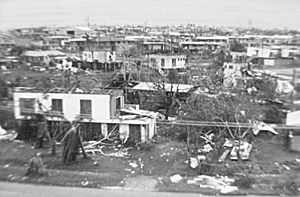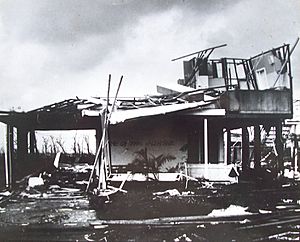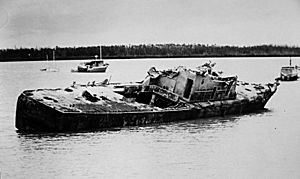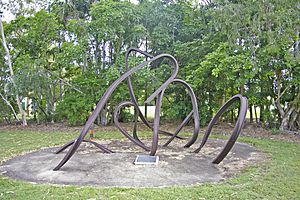Cyclone Tracy facts for kids
| Category 4 severe tropical cyclone (Aus scale) | |
|---|---|
| Category 3 tropical cyclone (SSHWS) | |
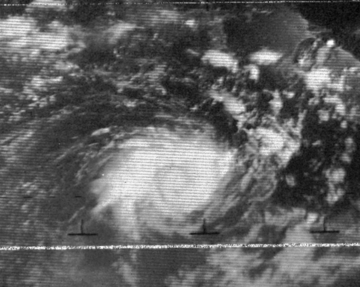
Cyclone Tracy on 25 December 1974
|
|
| Formed | December 21, 1974 |
| Dissipated | December 26, 1974 |
| Highest winds | 10-minute sustained: 175 km/h (110 mph) 1-minute sustained: 205 km/h (125 mph) Gusts: 240 km/h (150 mph) |
| Lowest pressure | 950 hPa (mbar); 28.05 inHg |
| Fatalities | 71 |
| Damage | $645.35 million (1974 USD) |
| Areas affected | Tiwi Islands, Northern Territory |
| Part of the 1974–75 Australian region cyclone season | |
Cyclone Tracy was a powerful tropical cyclone that hit Darwin, Australia. This happened between December 24 and 26, 1974. Many people in Darwin were getting ready for Christmas. They did not take the storm warnings seriously. This was partly because another cyclone, Selma, had just passed by. Also, few people were working at the news stations during the holiday.
Tracy caused a lot of damage. It killed 71 people. The storm also caused about A$837 million in damage (in 1974 money). This would be around A$7.2 billion today. More than 70 percent of Darwin's buildings were destroyed. This included 80 percent of the houses. About 30,000 people had to leave the city. Many of them never came back.
After the storm, Darwin was rebuilt. New buildings had to follow much stronger rules. These rules made them safer against cyclones. Tracy was the second-smallest tropical cyclone ever recorded. It was only bigger than Tropical Storm Marco in 2008.
Contents
How Did Cyclone Tracy Form?
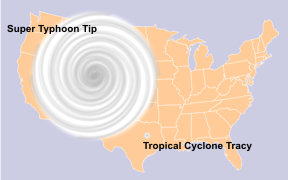
On December 20, 1974, weather experts saw a big cloud mass. It was over the Arafura Sea. This was about 230 miles (370 km) northeast of Darwin. The storm was officially called a tropical cyclone on December 21. It was then about 340 miles (550 km) northeast of Darwin. People first saw Cyclone Tracy on the Darwin radar on December 22.
A radio station, ABC Radio, said that day that Tracy was not a threat to Darwin. But early on December 24, Tracy changed direction. It moved around Cape Fourcroy on Bathurst Island. Then it headed straight for Darwin. The weather station at Cape Fourcroy measured strong winds. They were about 75 miles per hour (120 km/h) that morning.
Between 10:00 p.m. and midnight, people in Darwin realized the storm would hit them directly. The damage became very bad. The wind speed tool at Darwin Airport recorded a wind gust of 135 miles per hour (217 km/h). This was at 3:10 a.m. on December 25. The tool then stopped working. Weather experts believe gusts reached 150 miles per hour (240 km/h). After hitting land, Tracy quickly lost power. The storm was over by December 26.
Why Weren't People Ready for Tracy?
Darwin had been hit by cyclones before. This happened in January 1897 and March 1937. But in the 20 years before Tracy, Darwin grew very fast. The rules for building houses were not as strict back then. Most buildings could not handle a direct hit from a cyclone.
In the days before Cyclone Tracy, most people thought it would not harm Darwin. Cyclone Selma was supposed to hit Darwin ten days earlier. But it missed the city. People had heard many storm warnings before. When nothing happened, they stopped worrying. So, they did not pay much attention to the warnings for Tracy.
What Was the Impact of Cyclone Tracy?
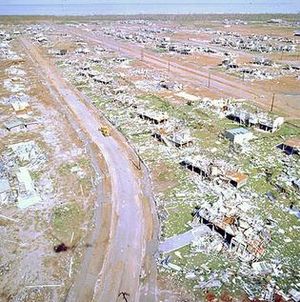
Cyclone Tracy killed 71 people. It destroyed over 70 percent of Darwin's buildings. The city's port and airport were also badly damaged. Two sailors from the Royal Australian Navy (RAN) died. Their patrol boat, HMAS Arrow, sank at Stokes Hill Wharf. The cyclone destroyed 31 airplanes. Another 25 were badly damaged.
The Australian government set up a group to check the damage. They also sent help where it was needed. All Defense Force members helped. The Royal Australian Air Force's transport planes also helped. They moved people out of Darwin by road and air. They also brought supplies. Thirteen RAN ships brought supplies as part of Operation Navy Help Darwin. This was the Navy's biggest help effort ever.
How Did Health Services Respond?
On Christmas Day, Darwin Hospital treated over 500 patients. They could admit 112 patients to stay. Local hospital workers kept going until a surgical team from Canberra arrived.
All official ways to communicate out of Darwin stopped working. Most radio station antennas were destroyed. The only local radio station that still worked was ABC's 8DR. For the next two days, it was Darwin's only link to the outside world. It stayed on air for almost all of the next few weeks.
About 30,000 people had no homes. They had to find shelter in temporary places. These places had no water or electricity. Because of poor hygiene, many faced the risk of diseases. Volunteers came from all over Australia. They dug temporary toilets and brought water. They also gave shots for typhoid and cholera. The army searched for people and animals. They also cleaned out spoiled food from fridges. After they searched and cleaned a house, they painted "S&C" on an outside wall.
The city was sprayed with a chemical called malathion. This was to control mosquitoes and other pests. City services started to clear away debris. They also worked to get their services back up and running.
What Happened After the Storm?
Rebuilding Darwin
In February 1975, Prime Minister Gough Whitlam announced a new group. It was called the Darwin Reconstruction Commission. Its job was to rebuild the city in five years. Some people wanted to move the city to a new place. But the government said it must be rebuilt in the same spot. Ella Stack became the mayor of Darwin in May 1975. She helped a lot with the rebuilding. By 1978, much of the city was fixed. It could hold almost as many people as before the cyclone. However, by the 1980s, about 60 percent of Darwin's 1974 population had left. They never came back. Today, Darwin looks very different from how it did before Tracy hit in December 1974.
Cyclone Tracy in Movies and Music
Bill Cate wrote a song called "Santa Never Made It into Darwin." Bill and Boyd sang it in 1975. This song helped raise money for rebuilding. In May 1976, the Australian band Ayers Rock released "Song for Darwin." This also helped raise money.
In 1986, the Nine Network made a TV show. It was called Cyclone Tracy. This mini-series was based on what happened during the cyclone. It included real news videos of the damage. It also had a documentary called On A Wind and a Prayer.
Interesting Facts About Cyclone Tracy
- Tracy was reported as a category four cyclone.
- People did not expect Tracy to hit Darwin. There had been many false alarms before. People thought Tracy's warnings were another one.
- It changed direction and headed straight for Darwin.
- It was small but very strong. Its strong winds reached only 40 miles (64 km) from its center.
- Darwin received 9.8 inches (250 mm) of rain in 12 hours.
- Most of Darwin's people were moved to Adelaide, Whyalla, Alice Springs, and Sydney.
- Cyclone Tracy is still one of Australia's biggest disasters.


